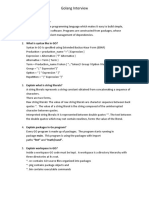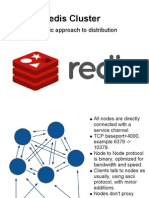Go Programming
Uploaded by
Dmytro ShteflyukGo Programming
Uploaded by
Dmytro ShteflyukFriday, May 21, 2010
Friday, May 21, 2010
Go Programming
Russ Cox and Rob Pike
May 20, 2010
Friday, May 21, 2010
Live waving
View live notes and ask questions about this session on
Google Wave:
http://bit.ly/go2010io
Friday, May 21, 2010
Go is different
Go is more unusual than you might first think.
Programming in Go is different from programming in most
procedural languages.
If you try to write Java* programs in Go, you may become
frustrated. If you write Go programs in Go, you will be much
more productive.
Our goal today is to teach you to think like a Go programmer.
*Sometimes we'll use Java as a reference for comparison but we could make the
same points comparing Go to a number of other languages.
Friday, May 21, 2010
Go is and Go is not
• Go is object-oriented not type-oriented
– inheritance is not primary
– methods on any type, but no classes or subclasses
• Go is (mostly) implicit not explicit
– types are inferred not declared
– objects have interfaces but they are derived, not specified
• Go is concurrent not parallel
– intended for program structure, not maximum performance
– but still can keep all the cores humming nicely
– ... and some programs are nicer even if not parallel at all
Friday, May 21, 2010
Friday, May 21, 2010
1: Evaluating expressions
Friday, May 21, 2010
A specification of behavior
Expression evaluators often define a type, called Value, as a
parent class with integers, strings, etc. as child classes.
In Go, we just specify what a Value needs to do. For our
simple example, that means: do binary operations and be
printable.
type Value interface {
BinaryOp(op string, y Value) Value
String() string
}
Implement those methods and you have a type that the
evaluator can use.
Friday, May 21, 2010
Integer values
Dead easy; just write the methods. (No extra bookkeeping.)
type Int int // A basic type (not a pointer, struct, or class).
func (x Int) String() string { return strconv.Itoa(int(x)) }
func (x Int) BinaryOp(op string, y Value) Value {
switch y := y.(type) {
case Int:
switch op {
case "+": return x + y
case "-": return x - y
case "*": return x * y
...
}
case Error: // defined on the next slide
return y
}
return Error(fmt.Sprintf("illegal op: '%v %s %v'", x, op, y))
}
Friday, May 21, 2010
Errors
For error handling, define an Error type that satisfies Value
that will just propagate the error up the evaluation tree.
type Error string
func (e Error) String() string {
return string(e)
}
func (e Error) BinaryOp(op string, y Value) Value {
return e
}
No need for "implements" clauses or other annotations. Ints
and Errors are Values because they satisfy the Value
interface implicitly.
Friday, May 21, 2010
Input
We need a basic scanner to input values. Here's a simple one
that, given a string, returns a Value representing an integer or
error.
func newVal(lit string) Value {
x, err := strconv.Atoi(lit)
if err == nil {
return Int(x)
}
return Error(fmt.Sprintf("illegal literal '%s'", lit))
}
The evaluator just tokenizes, parses and, in effect, calls
fmt.Println(newVal("2").BinaryOp("+", newVal("4")).String())
10
Friday, May 21, 2010
Friday, May 21, 2010
Demo
Friday, May 21, 2010
Let's add strings
type String string
func (x String) String() string { return strconv.Quote(string(x)) }
func (x String) BinaryOp(op string, y Value) Value {
switch y := y.(type) {
case String:
switch op {
case "+": return x + y
...
}
case Int: // String * Int
switch op {
case "*": return String(strings.Repeat(string(x), int(y)))
...
}
case Error:
return y
}
return Error(fmt.Sprintf("illegal op: '%v %s %v'", x, op, y))
}
12
Friday, May 21, 2010
String input
Just a few more lines in newVal.
func newVal(lit string) Value {
x, err := strconv.Atoi(lit)
if err == nil {
return Int(x)
}
s, err := strconv.Unquote(lit)
if err == nil {
return String(s)
}
return Error(fmt.Sprintf("illegal literal '%s'", lit))
}
We've added strings by just adding strings. This happens
because of Go's implicit interface satisfaction. No retroactive
bookkeeping.
13
Friday, May 21, 2010
Friday, May 21, 2010
Demo
Friday, May 21, 2010
Objects but no hierarchy
In Java, the type hierarchy is the foundation of the program,
which can be hard to change as the design evolves. (Can be
easier to compromise the design than change the foundation.)
Programming in Go is not primarily about types and
inheritance. There is no type hierarchy. The most important
design decisions don't have to be made first, and it's easy to
change types as the program develops because the compiler
infers their relationships automatically.
Go programs are therefore more flexible and adaptable.
15
Friday, May 21, 2010
Friday, May 21, 2010
2: Not inheritance
Friday, May 21, 2010
Java: Compressing using Buffers, given byte[] (1)
Suppose we have a zlib compressor:
public static class ZlibCompressor {
public int compress(byte[] in, int inOffset, int inLength,
byte[] out, int outOffset) {
...
}
...
}
and we want to support Buffer in a way that will generalize
to other compressors.
17
Friday, May 21, 2010
Java: Compressing using Buffers, given byte[] (2)
Define an abstract compressor class.
public abstract class AbstractCompressor {
/** Compresses the input into the output buffer. */
abstract int compress(byte[] in, int inOffset, int inLength,
byte[] out, int outOffset);
/**
* Compresses byte buffers using abstract compress method.
* Assumes Buffers are based on arrays.
*/
public void compress(Buffer in, Buffer out) {
int numWritten = compress(in.array(), in.arrayOffset() +
in.position(), in.remaining(), out.array(),
out.arrayOffset() + out.position());
out.position(out.position() + numWritten);
}
}
18
Friday, May 21, 2010
Java: Compressing using Buffers, given byte[] (3)
Subclass the abstract class to create a compression class.
public static class ZLibCompressor extends AbstractCompressor {
public int compress(byte[] in, int inOffset, int inLength,
byte[] out, int outOffset) {
...
}
}
This is common Java style: Inherit the abstract behavior.
19
Friday, May 21, 2010
Go: Compressing using Buffers, given []byte (1)
Again, we have a zlib compressor:
type ZlibCompressor struct { ... }
func (c *ZlibCompressor) Compress(in, out []byte) int
Again, we want to support Buffer in a way that will generalize
to other compressors.
20
Friday, May 21, 2010
Go: Compressing using Buffers, given []byte (2)
Define an interface for the compressor and write a function.
type Compressor interface {
Compress(in, out []byte) int
}
func CompressBuffer(c Compressor, in, out *Buffer) {
n := c.Compress(in.Bytes(), out.Bytes())
out.Advance(n)
}
This is good Go style: just use the abstract behavior.
It's easy and much less typing (in two senses).
You can use this approach in Java but it's not usual Java style.
Java (like many languages) puts type inheritance first.
21
Friday, May 21, 2010
Implicitness means flexibility
• In Go, could use as many wrappers as you like.
– A type can satisfy many interfaces and therefore be used by
any number of 'abstract wrappers' like CompressBuffer.
• In Java, can only extend one abstract class.
– Could use Java interfaces but still need to annotate the
original implementation — that is, edit the existing code.
– What if it's not yours to edit?
• In Go, Compressor's implementers do not need to know
about CompressBuffer or even the Compressor interface.
– The Buffer type might be private yet the type with the
Compress method could be in a standard library.
22
Friday, May 21, 2010
Friday, May 21, 2010
3: Lightweight interfaces
Friday, May 21, 2010
Interfaces are lightweight
• A typical Go interface has only one or two methods.
– (In fact, the commonest interface has zero, but that's
another story.)
• Programmers new to Go see interfaces as a building block
for type hierarchies and tend to create interfaces with many
methods.
• But that's the wrong way to think about them. They are:
– small
– nimble
– often ad hoc
24
Friday, May 21, 2010
Problem: Generalizing RPC
The RPC package in Go uses package gob to marshal objects
on the wire. We needed a variant that used JSON.
Abstract the codec into an interface:
type ServerCodec interface {
ReadRequestHeader(*Request) os.Error
ReadRequestBody(interface{}) os.Error
WriteResponse(*Response, interface{}) os.Error
Close() os.Error
}
25
Friday, May 21, 2010
Problem: Generalizing RPC
Two functions must change signature:
func sendResponse(sending *sync.Mutex, req *Request,
reply interface{}, enc *gob.Encoder, errmsg string)
becomes
func sendResponse(sending *sync.Mutex, req *Request,
reply interface{}, enc ServerCodec, errmsg string)
And similarly for requests.
That is almost the whole change to the RPC implementation.
The bodies of the functions needed a couple of tiny edits. In
other such examples, often no editing would be required.
We saw an opportunity: RPC needed only Read and Write
methods. Put those in an interface and you've got abstraction.
Post facto.
26
Friday, May 21, 2010
Total time: 20 minutes
And that includes writing and testing the JSON implementation
of the interface.
(We wrote a trivial gobServerCodec type to implement the new
rpc.ServerCodec interface.)
In Java, RPC would be refactored into a half-abstract class,
subclassed to create JsonRPC and GobRPC.
In Go, there is no need to manage a type hierarchy: just pass
in a codec interface stub (and nothing else).
27
Friday, May 21, 2010
Friday, May 21, 2010
4: Common interfaces
Friday, May 21, 2010
Post facto abstraction
In the previous example, we were in charge of all the pieces.
But it's common for interfaces to arise as codifications of
existing patterns.
Such interfaces often include only one or two methods:
io.Reader, io.Writer, etc.
It is vital that such interfaces do not need retrofitting to work
with existing code. They work automatically.
29
Friday, May 21, 2010
Simple interfaces are widely used
The type aes.Cipher has methods:
func (c *Cipher) BlockSize() int // size of encryption unit
func (c *Cipher) Decrypt(src, dst []byte) // decrypt one block
func (c *Cipher) Encrypt(src, dst []byte) // encrypt one block
So do blowfish.Cipher, xtea.Cipher and others. We can
make ciphers interchangeable by defining an interface:
type Cipher interface {
BlockSize() int
Decrypt(src, dst []byte)
Encrypt(src, dst []byte)
}
30
Friday, May 21, 2010
Chaining ciphers
We define block cipher modes using the interface.
// cipher-block chaining
func NewCBCDecrypter(c Cipher, iv []byte, r io.Reader) io.Reader
// cipher feedback
func NewCFBDecrypter(c Cipher, s int, iv []byte, r io.Reader)
io.Reader
// output feedback
func NewOFBReader(c Cipher, iv []byte, r io.Reader) io.Reader
Want AES CBC mode?
// (For brevity, we cheat a bit here about error handling)
r = block.NewCBCDecrypter(aes.NewCipher(key), iv, r)
Blowfish CBC?
r = block.NewCBCDecrypter(blowfish.NewCipher(key), iv, r)
No need for multiple CBC implementations.
31
Friday, May 21, 2010
Chain away
Libraries in other languages usually provide an API with the
cross product of all useful ciphers and chainers. Go just needs
to provide the building blocks.
And more! Decrypt and decompress by chaining further.
func DecryptAndGunzip(dstfile, srcfile string, key, iv []byte) {
f := os.Open(srcfile, os.O_RDONLY, 0) // open source file
defer f.Close()
c := aes.NewCipher(key) // create cipher
r := block.NewOFBReader(c, iv, f) // decrypting reader
r = gzip.NewReader(r) // decompressing reader
w := os.Open(dstfile, os.O_WRONLY | os.O_CREATE, 0666)
defer w.Close()
io.Copy(w, r) // copy to output
}
(Again, cheating a bit regarding error handling.)
32
Friday, May 21, 2010
Friday, May 21, 2010
5: Concurrency for structure
Friday, May 21, 2010
Concurrent programs
Java programmers use class hierarchies to structure their
programs.
Go's concurrency primitives provide the elements of another
approach.
It's not about parallelism. Concurrent programming allows
parallelism but that's not what it's really for.
It's about expressing program structure to represent
independently executing actions.
In short:
- parallelism is about performance
- concurrency is about program design
34
Friday, May 21, 2010
Example: a load balancer
Imagine you have many processes requesting actions and a
few workers that share the load. Assume workers are more
efficient if they batch many requests.
We want a load balancer that distributes the load fairly across
the workers according to their current workload.
In real life we'd distribute work across many machines, but for
simplicity we'll just focus on a local load balancer.
This is simplistic but representative of the core of a realistic
problem.
35
Friday, May 21, 2010
Life of a request
Requesters make a request to the load balancer.
Load balancer immediately sends the request to the most
lightly loaded worker.
When it completes the task the worker replies directly to the
requester.
Balancer adjusts its measure of the workloads.
36
Friday, May 21, 2010
A load balancer
Requester Requester Requester Requester ... many more
Balancer
To Requester To Requester
Worker Worker Worker Worker
37
Friday, May 21, 2010
Requester
The requester sends Requests to the balancer.
type Request struct {
fn func() int // The operation to perform
c chan int // The channel on which to return the result
}
An artificial but illustrative simulation of a requester.
func requester(work chan Request) {
c := make(chan int)
for {
time.Sleep(rand.Int63n(nWorker * 2e9)) // spend time
work <- Request{workFn, c} // send request
result := <-c // wait for answer
furtherProcess(result)
}
}
38
Friday, May 21, 2010
Worker
The balancer will send each request to the most lightly loaded
worker.
This is a simple version of a Worker but it's plausible.
func (w *Worker) work(done chan *Worker) {
for {
req := <-w.requests // get Request from load balancer
req.c <- req.fn() // call fn and send result to requester
done <- w // tell balancer we've finished this job
}
}
The channel of requests (w.requests) delivers requests to
each worker. The balancer tracks the number of pending
requests as a measure of load.
Note that each response goes directly to its requester.
39
Friday, May 21, 2010
Balancer
The load balancer needs a pool of workers and a single
channel to which requesters can send work.
type Pool []*Worker
type Balancer struct {
pool Pool
done chan *Worker
}
At this point, the balancer is very easy.
func (b *Balancer) balance(work chan Request) {
for {
select {
case req := <-work: // received a Request...
b.dispatch(req) // ...so send it to a Worker
case w := <-b.done: // a worker has finished a request...
b.completed(w) // ...so update its info
}
}
40
}
Friday, May 21, 2010
A heap of channels
How do we implement dispatch and completed?
We can use a heap to choose the most lightly loaded worker
by attaching the necessary methods to type Pool (Len, Push,
Pop, Swap, Less). That's easy; here for instance is Less:
func (p Pool) Less(i, j int) bool {
return p[i].pending < p[j].pending
}
And in each Worker, we keep a count of pending operations.
type Worker struct {
requests chan Request // work to do (a buffered channel)
pending int // count of pending tasks
index int // index in the heap
}
41
Friday, May 21, 2010
Use the heap to maintain balance
The implementation of dispatch and completed is easy:
// Send Request to worker
func (b *Balancer) dispatch(req Request) {
w := heap.Pop(&b.pool).(*Worker) // least loaded worker...
w.requests <- req // ...is assigned the task
w.pending++ // one more in its queue
heap.Push(&b.pool, w) // put it back in the heap
}
// Job is complete; update heap
func (b *Balancer) completed(w *Worker) {
w.pending-- // one fewer in its queue
heap.Remove(&b.pool, w.index) // remove it from heap
heap.Push(&b.pool, w) // put it back where it belongs
}
Channels are first-class values. We've built a heap of channels
to multiplex and load balance.
42
Friday, May 21, 2010
Friday, May 21, 2010
Demo
Friday, May 21, 2010
Discussion
Every operation blocks, yet this system is highly concurrent.
The combination of communication and synchronization is a
powerful tool.
{Closure, channel} pairs are a nice way to pass work around.
The closure says what to do; the channel lets the answer flow
directly back to the requester.
Channels can be part of other data structures and can be
passed between goroutines.
With very little work, you could use network channels or RPCs
to make this a distributed, networked load balancer. (Although
closures don't work across the network, RPCs help.)
44
Friday, May 21, 2010
Friday, May 21, 2010
Conclusion
Friday, May 21, 2010
Go is different
• Objects are not always classes
– Inheritance is not the only way to structure a program
• You don't need to specify everything in advance
– (And you shouldn't need to anyway)
– Implicitly satisfying behavior leads to pleasant surprises
• Concurrency is not just parallelism
– But it is a great way to structure software
46
Friday, May 21, 2010
Go is more productive
Go can make programming very productive:
- any type can be given methods, which opens up interesting
design possibilities.
- most of the bookkeeping of type-driven programming is
done automatically.
- the structuring power of concurrent programming leads
easily to correct, scalable server software.
Such properties make Go programs more malleable, more
adaptable, less brittle.
More at http://golang.org
47
Friday, May 21, 2010
Go is more fun
Go comes with T-shirts, tattoos and stickers.
48
Friday, May 21, 2010
Live waving
Please ask questions about this session on Google Wave:
http://bit.ly/go2010io
More about Go at http://golang.org
49
Friday, May 21, 2010
Friday, May 21, 2010
You might also like
- Bhagvan Kommadi - Learn Data Structures and Algorithms With Golang - Level Up Your Go Programming Skills To Develop Faster and More Efficient Code PDF100% (3)Bhagvan Kommadi - Learn Data Structures and Algorithms With Golang - Level Up Your Go Programming Skills To Develop Faster and More Efficient Code PDF324 pages
- Refactoring Improving The Design of Exis PDF0% (1)Refactoring Improving The Design of Exis PDF3 pages
- 97 Things Every Programmer Should Know Extended100% (3)97 Things Every Programmer Should Know Extended143 pages
- Why Rust?: Trustworthy, Concurrent Systems Programming100% (1)Why Rust?: Trustworthy, Concurrent Systems Programming60 pages
- Carlo Milanesi - Creative Projects For Rust Programmers - Build Exciting Projects On Domains Such As Web Apps, WebAssembly, Games, and Parsing-Packt Publishing (2020)No ratings yetCarlo Milanesi - Creative Projects For Rust Programmers - Build Exciting Projects On Domains Such As Web Apps, WebAssembly, Games, and Parsing-Packt Publishing (2020)396 pages
- Rust Programming Language - A Comprehensive Beginner - S Guide To Rust100% (1)Rust Programming Language - A Comprehensive Beginner - S Guide To Rust256 pages
- Gradle Essentials: Master the fundamentals of Gradle using real-world projects with this quick and easy-to-read guideFrom EverandGradle Essentials: Master the fundamentals of Gradle using real-world projects with this quick and easy-to-read guideNo ratings yet
- Brenden Matthews - Idiomatic Rust - Code Like A Rustacean (2024, Manning) - Libgen - Li100% (1)Brenden Matthews - Idiomatic Rust - Code Like A Rustacean (2024, Manning) - Libgen - Li257 pages
- Learning PHP 7 High Performance - Sample Chapter0% (1)Learning PHP 7 High Performance - Sample Chapter22 pages
- Agus Kurniawan - Go Programming by Example100% (1)Agus Kurniawan - Go Programming by Example165 pages
- The Way to Go: A Thorough Introduction to the Go Programming LanguageFrom EverandThe Way to Go: A Thorough Introduction to the Go Programming Language3/5 (4)
- Learning Go Programming: Build ScalableNext-Gen Web Application using Golang (English Edition)From EverandLearning Go Programming: Build ScalableNext-Gen Web Application using Golang (English Edition)No ratings yet
- Flask Blueprints: Dive into the world of the Flask microframework to develop an array of web applicationsFrom EverandFlask Blueprints: Dive into the world of the Flask microframework to develop an array of web applicationsNo ratings yet
- Operating Systems Interview Questions You'll Most Likely Be AskedFrom EverandOperating Systems Interview Questions You'll Most Likely Be AskedNo ratings yet
- Understanding The Top 5 Redis Performance MetricsNo ratings yetUnderstanding The Top 5 Redis Performance Metrics22 pages
- Backup Strategies With MySQL Enterprise BackupNo ratings yetBackup Strategies With MySQL Enterprise Backup33 pages
- Authors: Thanks To:: Miek Gieben Go Authors Google Go Nuts Mailing ListNo ratings yetAuthors: Thanks To:: Miek Gieben Go Authors Google Go Nuts Mailing List272 pages
- Scaling MySQL Writes Through PartitioningNo ratings yetScaling MySQL Writes Through Partitioning38 pages
- Calpont InfiniDB Administrator Guide (For Version 1.0.3)100% (2)Calpont InfiniDB Administrator Guide (For Version 1.0.3)106 pages
- Performance Tuning For The InfiniDB Analytics Database (For Version 1.0.3)100% (1)Performance Tuning For The InfiniDB Analytics Database (For Version 1.0.3)72 pages
- The Complete Google Analytics Power User Guide PDFNo ratings yetThe Complete Google Analytics Power User Guide PDF45 pages
- Building TweetReach With Sinatra, Tokyo Cabinet and GrackleNo ratings yetBuilding TweetReach With Sinatra, Tokyo Cabinet and Grackle21 pages
- Amdahl's Law in The Multicore Era - HPCA Keynote 02/2008No ratings yetAmdahl's Law in The Multicore Era - HPCA Keynote 02/200861 pages
- Hadoop Training #4: Programming With Hadoop100% (2)Hadoop Training #4: Programming With Hadoop46 pages
- KAIZEN PowerPoint Template - Exemplos ColoridosNo ratings yetKAIZEN PowerPoint Template - Exemplos Coloridos18 pages
- Hilti North American Product Technical GuideNo ratings yetHilti North American Product Technical Guide36 pages
- The Incredible Power of Post Selection (Scott Aaronson)100% (1)The Incredible Power of Post Selection (Scott Aaronson)33 pages
- There Is Different Conversion Function Which Used To Convert One Form of Data Into Another FormatNo ratings yetThere Is Different Conversion Function Which Used To Convert One Form of Data Into Another Format6 pages
- CCNASv1.1 Chp10 Lab-A ASA-FW-CLI StudentNo ratings yetCCNASv1.1 Chp10 Lab-A ASA-FW-CLI Student24 pages
- Instruction List Programming: PLC Il - 18.1No ratings yetInstruction List Programming: PLC Il - 18.110 pages
- In5320 f18 - Individual Assignment 1 PDFNo ratings yetIn5320 f18 - Individual Assignment 1 PDF6 pages
- SAP CO Certification Mindmap - 1557395025No ratings yetSAP CO Certification Mindmap - 15573950252 pages
- Comparative Difference Between Various Disk Scheduling Algorithms Fcfs SSTF Scan C-Scan LookNo ratings yetComparative Difference Between Various Disk Scheduling Algorithms Fcfs SSTF Scan C-Scan Look13 pages
- Bhagvan Kommadi - Learn Data Structures and Algorithms With Golang - Level Up Your Go Programming Skills To Develop Faster and More Efficient Code PDFBhagvan Kommadi - Learn Data Structures and Algorithms With Golang - Level Up Your Go Programming Skills To Develop Faster and More Efficient Code PDF
- Why Rust?: Trustworthy, Concurrent Systems ProgrammingWhy Rust?: Trustworthy, Concurrent Systems Programming
- Carlo Milanesi - Creative Projects For Rust Programmers - Build Exciting Projects On Domains Such As Web Apps, WebAssembly, Games, and Parsing-Packt Publishing (2020)Carlo Milanesi - Creative Projects For Rust Programmers - Build Exciting Projects On Domains Such As Web Apps, WebAssembly, Games, and Parsing-Packt Publishing (2020)
- Rust Programming Language - A Comprehensive Beginner - S Guide To RustRust Programming Language - A Comprehensive Beginner - S Guide To Rust
- Gradle Essentials: Master the fundamentals of Gradle using real-world projects with this quick and easy-to-read guideFrom EverandGradle Essentials: Master the fundamentals of Gradle using real-world projects with this quick and easy-to-read guide
- Brenden Matthews - Idiomatic Rust - Code Like A Rustacean (2024, Manning) - Libgen - LiBrenden Matthews - Idiomatic Rust - Code Like A Rustacean (2024, Manning) - Libgen - Li
- The Way to Go: A Thorough Introduction to the Go Programming LanguageFrom EverandThe Way to Go: A Thorough Introduction to the Go Programming Language
- Learning Go Programming: Build ScalableNext-Gen Web Application using Golang (English Edition)From EverandLearning Go Programming: Build ScalableNext-Gen Web Application using Golang (English Edition)
- Flask Blueprints: Dive into the world of the Flask microframework to develop an array of web applicationsFrom EverandFlask Blueprints: Dive into the world of the Flask microframework to develop an array of web applications
- Operating Systems Interview Questions You'll Most Likely Be AskedFrom EverandOperating Systems Interview Questions You'll Most Likely Be Asked
- Authors: Thanks To:: Miek Gieben Go Authors Google Go Nuts Mailing ListAuthors: Thanks To:: Miek Gieben Go Authors Google Go Nuts Mailing List
- Calpont InfiniDB Administrator Guide (For Version 1.0.3)Calpont InfiniDB Administrator Guide (For Version 1.0.3)
- Performance Tuning For The InfiniDB Analytics Database (For Version 1.0.3)Performance Tuning For The InfiniDB Analytics Database (For Version 1.0.3)
- The Complete Google Analytics Power User Guide PDFThe Complete Google Analytics Power User Guide PDF
- Building TweetReach With Sinatra, Tokyo Cabinet and GrackleBuilding TweetReach With Sinatra, Tokyo Cabinet and Grackle
- Amdahl's Law in The Multicore Era - HPCA Keynote 02/2008Amdahl's Law in The Multicore Era - HPCA Keynote 02/2008
- The Incredible Power of Post Selection (Scott Aaronson)The Incredible Power of Post Selection (Scott Aaronson)
- There Is Different Conversion Function Which Used To Convert One Form of Data Into Another FormatThere Is Different Conversion Function Which Used To Convert One Form of Data Into Another Format
- Comparative Difference Between Various Disk Scheduling Algorithms Fcfs SSTF Scan C-Scan LookComparative Difference Between Various Disk Scheduling Algorithms Fcfs SSTF Scan C-Scan Look















































































































